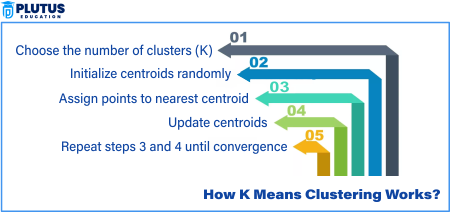K means clustering in machine learning that belongs to the category of unsupervised learning, as it detects clusters in data. It does this by separating the dataset into K number of clusters that are similar by feature. In other words, identical data points in a cluster, while different data points remain separate. A simple and frequently used algorithm that uncovers hidden patterns, groups, and makes correlated data patterns in unlabeled data, highly useful in finding groupings in diverse data. This is probably one of the most commonly used algorithms in the real-world ML task such as customers segmentation, and, market research. K means clustering in machine learning is an intelligent and is one of the simplest way of accessing the data in an unlabeled manner.
K Means Clustering in Machine Learning
K means clustering is an algorithm related to clustering the data based on similarity. For instance, an online store where organization uses K Means, to geolocate customers based on purchase frequency and spending thereby creating segments Budget Shoppers, Frequent Customers and Big Spenders for personalized marketing
It randomly selects a few central points called centroids, and each data point is assigned to the closest centroid, forming a cluster. Once, all the points are assigned a cluster then we update the centroids by calculating the average position of points in a cluster. This procedure is repeated until their centroids don’t change which forms clusters. Clustering is the task of grouping a set of points so that points in the same cluster are similar to each other.
How K Means Clustering Works?
This insight into how k means in machine learning functions makes you more effective as you apply it to projects. It iteratively refines clusters until it finds an optimal arrangement.

Choose the number of clusters (K)
Choose the number of clusters you get to make from your dataset. We will call this number K and you need to select K based on your data and patterns that you are trying to find. If you cluster too few, you will have different classifications in the same group. On the other hand, if you select too many, you will split close data into different clusters. Use techniques such as elbow method or domain knowledge to aid in choosing the appropriate K.
Initialize centroids randomly
Randomly sample K data points from your data set to be the first centroid. Clusters are represented by their centroid, or the center of their points. This step provides an initial state for the algorithm to operate from. These centroids are not fixed in place. Depending on how data points cluster around them, the algorithm will tweak them later. Different starting points across the algorithm help it find different parts of this data.
Assign points to nearest centroid
At this point, we need to calculate the distance for each data point to all the centroids. Once you have those k centroids you can use some method like the Euclidean distance to see which one is the closest to each point. Group points according to the closest centroid. This stage creates the first clusters. All the points in a cluster will be closer to their shared centroid than they will to any points in other clusters.
Update centroids
Making the centroids is the next step after grouping the data points. Calculate the new centroid by taking the average position of all points in a cluster. This ensures that it (the centroid) travels toward the mean of the points in its cluster. This will effectively make the new centroids better represent the cluster in the next round.
Repeat steps 3 and 4 until convergence
The process of assigning points and then updating centroids is repeated repeatedly. Repeat until the centroids do not change or change very little. The algorithm converged when this occurs. This indicates that the clusters have stabilized, and that the K-means algorithm has completed grouping the data.
Cluster Evaluation Metrics
After we apply k means clustering in machine learninig, we neet to check, whether it worked fine or not. Evaluation metrics basically provide us with the information regarding how well the clusters are formed. The performance evaluation of k means clustering will allow you to ensure that the results which you have obtained are reliable and meaningful. However, never finals any decision based on only one data metric.
- Inertia (Within-cluster sum of squares): Inertia measures how similar each point in a cluster is to other points in the cluster. Low inertia indicates tight, well-formed clusters. By looking at the average distances between points in clusters, tells you whether or not the data is well-clustered in the number of clusters you got. It can be used to compare the results of different clusterings.
- Silhouette Score: The silhouette score indicates how close a data point is to other points in the same cluster compared to points in other clusters. The score can vary from -1 to 1; the closer to 1, the better the clustering. It tells you whether your clusters are distinct and separate enough.
- Davies-Bouldin Index: This index comprises two parameters: how close the points are in a cluster and how far apart each cluster is from another. A smaller Davies-Bouldin index indicates better clusters. It provides you with a quick check on your clustering model quality.
- Dunn Index: The dunn index evaluates the separation and compactness of the clusters. Higher values indicate better clustering with distinct gaps between clusters. It enables you to choose the optimum model when comparing multiple clustering outcomes.
Applications in Machine Learning
Machine lkearning has a lot of different applications in different fields and K means is one of the clustering algorithms. It assists in the joining, summarizing, and making decisions in everything from business analytics to healthcare. K means clustering underlies numerous machine learning workflows, particularly in fields where labeled data is unavailable. It assists organizations in utilizing unlabeled data to make educated decisions,
Customer Segmentation
Companies use customer segmentation to harvest smaller groups of customers based on likes, behaviours or buying habits. Advertisers use this method to understand each group better and target their ads based on what they would be interested in. It assists in delivering the correct message to the correct recipients, rendering campaigns more effective and budget-friendly. Understanding what customers love allows companies to offer personalized services and boost customer satisfaction.
Image Compression
For example, in image compression, we use clustering to reduce the number of colours or pixels in an image. This helps reduce the image file size while preserving most of its quality. It classifies adjacent pixel colours into similar groups and replaces them with a shared value. This takes up less space in storage and loads images on a website or app faster. This technique shares or stores images where speed and memory usage are essential.
Document Clustering
Document clustering clusters similar text documents like news articles, blog posts, or emails based on their content or topics. This simply sorts the information and allows users to find the content they seek easily. This technique improves search engines and recommendation systems by presenting the most relevant content first. This enables businesses, libraries and media platforms to structure large amounts of text in a relevant way.
Anomaly Detection
Anomaly detection detects those data points which do not conform to an expected data pattern. It is pretty useful in fraud detection, system monitoring, and network security. For instance, banks use it to detect unusual activity that could be fraudulent. In IT, it helps identify errors or failures before they create large issues. It works by finding groups of typical data and classifying everything that falls outside the clusters as abnormal.
Health Care
In health care, clustering allows doctors and researchers to segment patients with similar symptoms, test results or responses to treatment. This leads to more accurate diagnoses and improved treatment strategies. Hospitals can forecast disease surges help manage patient care and get them in and out more easily. It also enables personalized medicine — a type of treatment in which each person receives care tailored to their individual needs.
Relevance to ACCA Syllabus
K means clustering in machine learning algorithm that helps build such machine learning models that assign data points to K clusters based on their similarities, and the knowledge of such machine-learned models is useful while preparing for ACCA Strategic Business Leader (SBL) and Strategic Business Reporting (SBR) papers, where one of the key areas is the knowledge of digital technologies and data analytics tools. ACCA focuses on the use of big data in audit, assurance, financial planning and performance management. K means: this method is used to arrange your data for spotting patterns, so this can be used in audit analytics, failed customer segmentation, fraudulent detection and credit risk.
K Means Clustering ACCA Questions
Q1: What is k-means clustering mainly used for when analyzing audit data?
(A) By sorting data chronologically
B) To cluster data into groups of like data
C) To encrypt the audit information
D) For checking financial ratios
Ans: B) Grouping data into similar clusters
Q2: The k-means clustering method can be used on which of the following tasks in ACCA audit analytics?
A) Preparing ledgers
B) Verifying journal entries
C) Identifying unusual activity in transactional behaviour
D) Calculating tax liability
Q. Ans: C) Identify anomalies in transactional patterns
Q3: What type of dataset is ideal for k-means clustering?
A) Unstructured data
B) Sequential data
C) Defined features with numerical data
D) Text data
Q) What type of data you can use to train your model?
Q4 And how does k-means clustering help with performance management reports?
A) By calculating margins
B) Segmenting business units by performance
C) Through interest rate calculations
D) Forecasting sales directly
Ans: B) Segmenting the business units & tracking the performance
Q5: Which ACCA syllabus subject does it cover analytics tools like k-means?
A) Taxation
B) Strategic Business Leader
C) Audit and Assurance
D) Financial Management
Ans: B) Strategic Business Leader
Relevance to US CMA Syllabus
US CMA consists of management accounting and strategic financial management concerning data analytics in decision-making. Part 1: Financial Planning, Performance, and Analytics: Students must know predictive and descriptive analytics. These lead to better budgeting, forecasting, and variance analysis via k-means clustering for customer or cost center segmentation.
K Means Clustering US CMA Questions
Q1: Why is k-means clustering important for better budgeting in management accounting?
A) By eliminating cash flow
B) In the case that we have averaged all the transactions
C) By aggregating like cost centers with similar expense behavior
D) By removing fixed costs
Ans: C) By grouping cost centers with similar expense behavior
Q2: In performance analysis, management can use k-means clustering to:
A) Avoid variance analysis
B) Recognize the behavior of costs
C) Hide loss-making units
D) Calculate depreciation
Ans: B) Establish the pattern of cost behavior
Q3: What is the necessary step before applying k-means clustering in a CMA analysis?
A) Adding random numbers
B) Encoding variables
C) Data normalization or scaling
D) Turn off the decimal places
Ans: (C): Normalizing or scaling the data
Q4: How can k-means help in customer profitability analysis?
A) Treating all customers the same
B) Alphabetical order of customers
C) Segmenting customers based on profitability attributes
D) Letting go of low-value customers
Ans: C) Driver of consumer by profitability characteristic
Q5: Techniques such as clustering are part of the CMA exam part two.
A) Part 2
B) Part 1
C) Both Part 1 and Part 2
D) None
Ans: B) Part 1
Relevance to CFA Syllabus
Let’s consider the CFA curriculum at Levels II and III. There is a good amount of focus on quantitative methods and machine learning techniques in portfolio management and risk analytics. The K means clustering is commonly employed in asset grouping, anomaly detection and in portfolio diversification by clustering stocks with correlated price behaviour or fundamentals. It also fits the increasing trend of using AI and ML in investment decision-making.
K Means Clustering CFA Questions
Q1: In portfolio management, k-means clustering can be used to help:
A) Reduce market volatility
B) Group securities that are similar with respect to their risk-return profile
D) Exclude outliers in valuation
D) Predict interest rates
Ans: B) Group securities with same risk-return profiles
Q2: As a CFA charterholder, where would you leverage k-means clustering in your equity analysis?
B) Automating trade executions
B) In fundamental indicators for stock clustering
C) To eliminate all risk
D) To increase company profit
Ans: B) To classify stocks based on certain fundamental parameters
Q3: From the perspective of k-means clustering, which stage is solely employed to determine the number of groups?
A) pca
B) Scree plot method
C) Elbow method
D) Residual testing
Ans: C) Elbow method
Q4. What’s one example of a weakness of k-means clustering when modeling concepts in finance?
A) Requires labeled data
B) Outliers and scale sensitive
(C) unable to group numeric data
D) Does not allow iteration
Ans: B) Not robust to outliers and scale
Q5: At what level of CFA are machine learning tools, such as clustering, covered?
A) Level I
B) Level II
C) Level III
D) All Levels
Ans: B) Level II
Relevance to US CPA Syllabus
The CPA exam includes emerging technologies and data analytics in the Business Environment and Concepts (BEC) and Audit (AUD) sections of the US CPA exam. CPAs are more and more called on to analyze large datasets, find anomalies, and based on it help to business decision making. And K-means clustering can be used if the business is to identify transaction patterns, detect fraud clusters or improve audit tasks.
K Means Clustering US CPA Questions
Q1: Which process of audit can be aided by k-means clustering?
A) Sampling ledger entries
B) Verification of customer balances
C) Identifying anomalous groups of transactions
D) Filing tax returns
A: C) Finding anomalous clusters in transactions
Q2: You can have K-means clustering in CPA’s Job:
A) Automate Inventory Counting
B) Validate journal entries
C) Request money laundering transaction alerts on client accounts
D) Assign tax slabs
Ans: C) Detect suspicious activity in customer accounts
As a k-means practitioner in an audit file, CPAs must first:
A) Archive the file
B) Cluster alphabetically
C) Texting the numerical columns
D) Altering accounting regulations
Ans: C)Preprocess the numerical data
A4: Data analytics tools are discussed in the Enivronment and Concepts part of the CPA exam.
A) BEC
B) AUD
C) REG
D) FAR
Ans: A) BEC
Q5: A CPA can find out the best segments using k-means.
A) Random records
B) Financial statements
C) Vendors by transaction volume
D) Depreciation schedules
Ans: C) Transactions Volume receipt Vendor


